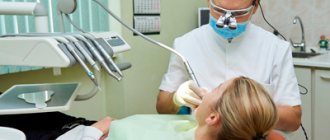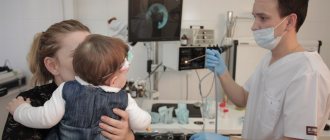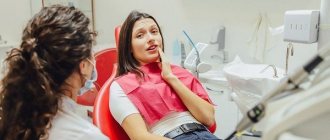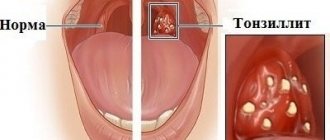Content:
- Causes of pathology
- Signs of inflammation of the submandibular lymph nodes 1.1. First stage 2.2. Second stage 2.3. Third stage
- How to cure an enlarged lymph node in the submandibular area
- Prevention of the inflammatory process
Inflammation of the submandibular lymph node is one of the most common types of lymphadenitis.
Its development is caused by inflammatory processes occurring in the oral cavity and less often in other parts of the body. Often the problem occurs with advanced caries, pulpitis, gingivitis, and inflammatory lesions of the tonsils. It is also caused by throat diseases. Let's take a closer look at why the submandibular lymph nodes are enlarged and what should be done to normalize the situation.
Fact #2
Lymphatic vessels are not something abstract.
It is worth crossing or ligating them, for example, during surgery on the axillary lymph nodes for breast cancer, and lymphostasis is likely to develop - swelling of the limb, which, again, most likely will not go away.
The most visible to us from the point of view of examination - the so-called peripheral lymph nodes (in the neck, supraclavicular, axillary and inguinal) can increase, and this is in most cases a manifestation of reactive lymphadenopathy - an inflammatory reaction indicating the fight against infection.
Causes of pathology
If the lymph node changes its size, it can be assumed that a viral or bacteriological infection has spread. Taking into account the localization of the lesion, the doctor understands exactly where the source of the disease is located and which organs need urgent medical attention.
Among the dental provocateurs of enlarged submandibular lymph nodes:
- inflammation of the salivary glands;
- gingivitis;
- pulpitis;
- flux;
- stomatitis;
- alveolitis;
- periodontitis;
- deep caries;
- inflammation occurring under the crowns.
But the violation is not always associated specifically with dental diagnoses. Its reasons are:
- Respiratory diseases: pharyngitis, laryngitis, rhinitis.
- Pathologies related to the bone structures of the skull: damage to the bone structures of the lower jaw, damage to the temporomandibular joint, articular capsule.
- Infections: sore throat, measles, tonsillitis, otitis media, chicken pox, mumps. In all these cases, the lymphatic tissues swell a few days after the first symptoms of the disease appear.
- Specific pathologies caused by pathogenic pathogenic agents: toxoplasmosis, tuberculosis, syphilis, gonorrhea.
- Oncological neoplasms. Lymphatic tissue always reacts very sharply to tumor growth. Enlarged submandibular lymph nodes sometimes indicate the presence of a neoplasm in the area of the tongue, neck, or salivary glands.
- Autoimmune disorders. Always associated with disruptions in the functioning of the immune system. Then, by mistake, lymphocytes begin to treat healthy cells as dangerous pathogens. They destroy them, causing inflammation of the lymph nodes.
- Hyperthyroidism. With an exacerbation of this disease, the neck and cheek area swells, the lymph nodes become more voluminous.
In young children, parents may notice large round “balls” under the jaw during the period of active teething. This often causes an increase in body temperature. There is no need to be afraid of such symptoms. It is associated precisely with the inflammatory process provoked by the eruption of milk units. But, if the situation does not return to normal within three to five days, it is still worth showing the baby to a pediatric dentist, surgeon or pediatrician.
Signs of inflammation of the submandibular lymph nodes
How the disorder manifests itself depends on how far the disease process has progressed. If you do not carry out the necessary therapeutic measures, one stage will quickly pass into another.
First stage
The size of the lymph nodes changes very slightly, but the person already feels that they hurt when pressed. Discomfort occurs when turning the head. Body temperature often rises and a sore throat appears. A tickle or dry, unproductive cough is annoying. Pain occurs only on one side of the neck or on both sides at once. The first case is more likely if it is a viral disease.
Second stage
It is called “acute lymphadenitis”. Now the lymph node can be distinguished visually - it becomes convex and protrudes forward. Externally it resembles a subcutaneous ball. Its diameter reaches three centimeters, but can be more impressive.
The node is painful to the touch. Because of this, it is difficult for the patient to turn and tilt his head, and open his mouth wide. The mobility of the upper and lower jaw is significantly limited.
The pain may radiate to the cheek or ear. Body temperature increases. Overall performance decreases.
Third stage
Called purulent lymphadenitis. Here, the inflammatory process even affects structures adjacent to the lymph node. The patient complains of pain in the throat, collarbone, armpit, and head. The nerve endings of the teeth may become inflamed. Then acute toothache occurs.
Pus formed in lymphoid tissues consists mainly of necrotic cells. If it gets into the blood (and such a possibility always exists), the outcome can be extremely unfavorable, so the inflammatory process should not be started.
Patients can understand that the submandibular lymph node is inflamed and needs treatment as soon as possible by the following signs:
- the “ball” enlarges and becomes red or bluish;
- every day it becomes more dense and solid;
- the skin located above the lymph node takes on a red tint and is hot to the touch;
- the lower jaw area swells.
Causes and features of enlarged lymph nodes in various diseases
Most often, enlarged lymph nodes are a marker of immune or infectious diseases, including:
- acute respiratory viral infections (pharyngitis, tonsillitis) are the most common cause of enlarged lymph nodes; they are moderately painful, dense to the touch, their mobility is preserved;
- lymphadenitis - develops in the presence of a purulent process in the body, the lymph nodes are significantly enlarged, motionless and sharply painful on palpation, the skin over them turns red;
- tuberculosis - most often changes become noticeable in the lymph nodes of the chest cavity, less often in the neck; at first, the lymph nodes are moderately painful, but as the underlying disease develops, they adhere to each other and to the surrounding tissues, threatening to form a serious fistula;
- rubella – the cervical, parotid, and occipital nodes may enlarge; they are moderately painful and do not adhere to surrounding tissues;
- syphilis - an increase in nodes in the groin, not always painful, which is later replaced by the development of hard chancre on the genitals;
- HIV infection – lymph nodes of all groups enlarge, while for a long time other symptoms of pathology in the body may not be detected;
- autoimmune diseases (systemic lupus erythematosus, rheumatoid arthritis, sarcoidosis, autoimmune thyroiditis) - lymph nodes of all regional groups can enlarge;
- oncological pathologies - lymph nodes enlarge either due to metastasis from malignant neoplasms, or from diseases that attack the lymphatic system itself (Hodgkin's lymphoma and non-Hodgkin's lymphomas).
Taking certain medications (for example, hydralazine) can also cause changes in the size of lymph nodes. Another reason may be the presence of silicone prostheses in the body, which the lymphatic system perceives as a foreign body and gives a signal about the development of an inflammatory process. We can talk about both breast implants and prosthetic arms, legs and other parts of the body.
How to cure an enlarged lymph node in the submandibular area
Therapy must be carried out under medical supervision. Its main goal is to eliminate the infection that caused the disorder. If the root cause of the condition is not established, it will not be possible to be completely cured.
If the problem is related to an oral disease, mandatory treatment is carried out. For severe inflammatory pathologies of internal organs, antibiotic therapy is carried out. For pathologies of a viral nature, patients are prescribed antiviral drugs.
If the examination reveals that pus has accumulated inside the tissues, it is drained using a drainage tube. Additionally, a puncture is taken to recognize the pathogen and understand whether the disease has a benign or malignant course.
As soon as the infectious focus disappears, the lymph nodes begin to shrink, stop hurting and gradually reach their normal state.
Treatment of enlarged lymph nodes
There is no specific treatment regimen, since enlarged lymph nodes are a symptom of a specific disease, and it is this disease that needs to be treated. If the increase is the result of a cold, no special measures are required to eliminate the symptom. The size of the nodes returns to normal as the underlying disease is treated as part of antibacterial or antiviral therapy using immunomodulatory agents.
A long-term infectious process, against the background of which the lymph nodes have swollen and become visually noticeable and painful on palpation, requires urgent consultation with a doctor. Depending on the etiology of the disease, you may need the help of an otolaryngologist, pediatrician, infectious disease specialist, and specialists in other fields. If you suspect malignant tumors, you should consult an oncologist.
Prevention of the inflammatory process
To reduce the risk of developing lymphadenitis, you must strictly follow the recommendations:
- Have annual preventive examinations at the dental clinic. Treat all emerging oral diseases in a timely manner. Avoid caries and take care of your gums.
- Do not ignore the presence of infections and treat them. During therapy, strictly follow all medical prescriptions.
- For any damage to the skin, treat wounds with antiseptics. This minimizes the risk of contracting an infectious disease.
- If you feel unwell, consult a doctor and get laboratory tests. This simple measure allows you to detect violations at the earliest stages.
It is necessary to understand that using “grandmother’s” methods for inflamed lymph nodes is dangerous. So, under no circumstances should you heat the inflamed area or apply cold compresses to it. It is unacceptable to massage him or put pressure on him. All of these actions can make the situation worse. Then it will be much more difficult to reverse the disease.








